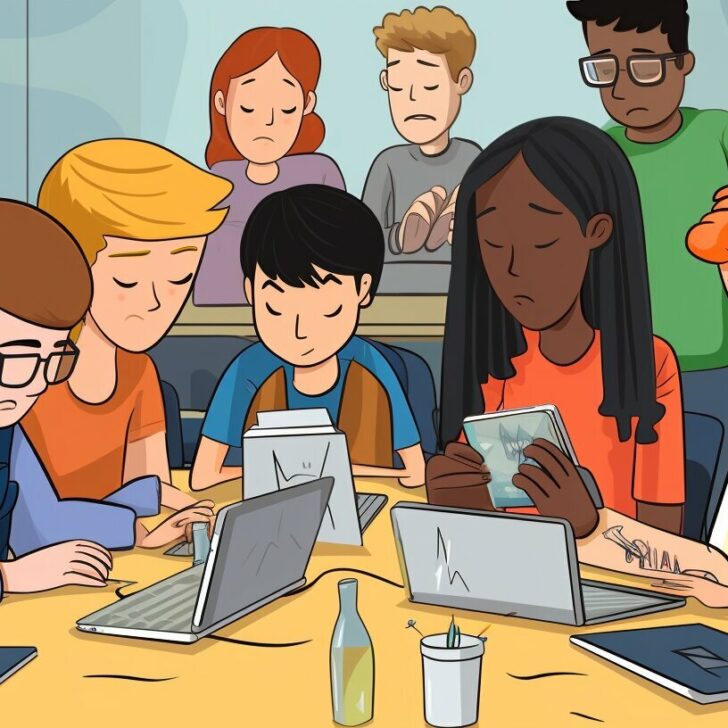Collaborative learning is an effective educational approach that encourages students to work together to achieve learning outcomes.
However, despite its numerous benefits, there are also some problems with collaborative learning that need to be addressed to ensure its success.
In this article we will explore some of the challenges that can arise when implementing collaborative learning, including the disadvantages, drawbacks, and obstacles that can impact the effectiveness of the learning experience.
Key Takeaways:
- Collaborative learning has limitations that can impact its effectiveness
- These limitations include different speeds of work, dominant group members, discomfort of quiet individuals, interpersonal conflicts, unequal contribution, and lack of self-discovery
- Addressing these limitations is crucial for optimizing the educational experience through collaborative learning
Different Speeds of Work
One of the disadvantages of collaborative learning is that people often work at different speeds. This can be problematic when working on group projects or assignments, especially among students with varying learning abilities and skill levels.
For some individuals, grasping concepts may come naturally, allowing them to complete tasks quickly. Others may require more time to understand and process information.
When working in a group, this can create challenges, as it may lead to unequal participation and frustration among group members.
Students who work at a slower pace may get left behind, while others may feel held back by the pace of the group. This can also lead to conflicts between group members.
In dealing with this limitation, it is important to establish clear expectations and guidelines from the outset. Encourage open communication among group members to discuss potential issues and find ways to work collaboratively despite differences in work speed.
By doing so, you can ensure that everyone is able to contribute and succeed within the group setting.
Dominant Group Members
Another one of the challenges of collaborative learning is dominant members. When working in a group, it is not uncommon to have individuals who attempt to take control of the situation. These group members may be forceful in asserting their ideas and opinions, often drowning out the voices of other members.
This can be particularly problematic in collaborative learning settings where all members are expected to contribute equally.
When this occurs, it can cause frustration among group members and even result in conflict. It may lead to other members feeling discouraged or disengaged, leading to less productive group work and a negative impact on learning outcomes.
It is important to address this issue by establishing group guidelines and promoting effective communication. Encouraging equal participation and ensuring all members have an opportunity to share their thoughts can help prevent a single member from dominating the group dynamic.
By fostering a positive and inclusive environment, collaboration can be improved and a more effective learning experience can be achieved.
Discomfort of Quiet Individuals
Another of the issues with collaborative learning is that it can be challenging for quiet individuals who may not feel comfortable speaking up in a group setting. This situation can be problematic for group members, and limit interaction between different individuals.
In this case, the quiet person may have concerns about their contributions or might not feel confident enough to engage fully in group discussions.
To address this problem, group members can foster a supportive and inclusive environment that encourages participation from everybody involved. Building trust and open communication can provide a safe space for quiet individuals to express their ideas and engage in group discussions.
It is important to provide opportunities for quiet individuals to contribute, such as taking turns to speak or posing questions that allow for all group members to share their perspectives.
Effective communication is a key behavior for overcoming the discomfort of quiet individuals in collaborative learning environments.
By recognizing the unique challenges faced by quiet individuals, group members can work together to create an inclusive and engaging learning experience for everyone involved.
Lack of Self-Discovery
Another one of the downsides of collaborative learning is that it sometimes hinders self-discovery. Collaborative learning involves working with others to understand and grasp concepts, which can be beneficial.
However, when concepts are not self-discovered through individual effort, they may be less clear and lack a deeper understanding. This limitation can hinder your learning as it may prevent you from fully grasping concepts and applying them in real-life situations.
It is important to strike a balance between collaborative efforts and individual exploration and reflection to promote self-discovery. By taking the time to work on problems individually, you can gain a deeper understanding of concepts and better identify areas where you may need additional support.
This can help you become a more effective learner and maximize the benefits of collaborative learning.
Additionally, when working in a group, it is crucial to ensure that each member has the opportunity to explore concepts individually. Encourage everyone to share their thought processes, insights, and perspectives, and create opportunities for individual reflection and analysis.
By doing so, you can promote self-discovery and help each member contribute more effectively to the group’s learning process.
Conclusion
As shown in even the biggest of companies, collaborative learning can offer a valuable educational experience, promoting teamwork, critical thinking, and communication skills. However, it is essential to know the limitations of collaborative learning.
Some of the downsides of collaborative learning are: Individuals may work at different speeds, dominant group members can overpower quieter individuals, and quiet individuals may not feel comfortable speaking up.
The last of the drawbacks of collaborative learning is that it’s important to balance collaborative efforts with individual exploration and reflection to promote self-discovery and deeper understanding of concepts.
By acknowledging and addressing obstacles in collaborative learning, employers, educators, and learners can work together to navigate challenges, promote equal participation, foster positive group dynamics, and optimize the educational experience through collaborative learning.
FAQ For What Are The Limitations of Collaborative Learning?
Q: What are the limitations of collaborative learning?
A: Collaborative learning can face several limitations or challenges that can affect its effectiveness. These limitations include different speeds of work, dominant group members, discomfort of quiet individuals, interpersonal conflicts, unequal contribution, lack of self-discovery, and more.
Q: What is the impact of different speeds of work in collaborative learning?
A: Different speeds of work can create challenges in group work as individuals may grasp concepts at varying rates. This can lead to unequal participation and frustration among group members.
Q: How can dominant group members hinder collaborative learning?
A: Dominant group members who assert their ideas forcefully can overpower quieter individuals, hindering collaboration and preventing equal participation.
Q: How does collaborative learning affect quiet individuals?
A: Collaborative learning can be challenging for quiet individuals who may not feel comfortable speaking up. This reluctance to participate can limit their contributions and hinder the overall effectiveness of the learning experience.
Q: What are the potential interpersonal conflicts in collaborative learning?
A: Collaborative learning often requires students to work closely with others, which can lead to interpersonal conflicts. Differences in personalities, perspectives, or communication styles can create tension within the group and negatively impact the learning process.
Q: How does unequal contribution affect collaborative learning?
A: Unequal contribution from group members can impact the quality of the learning experience. Some individuals may contribute more actively, while others may contribute less or rely heavily on their peers.
Q: What is the limitation of collaborative learning in terms of self-discovery?
A: Collaborative learning may limit individual self-discovery of concepts. If concepts are not self-discovered through individual effort, they may be less clear and lack a deeper understanding.

